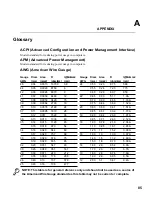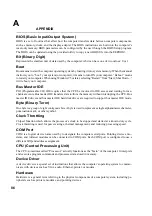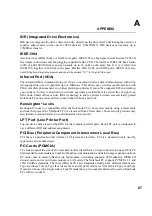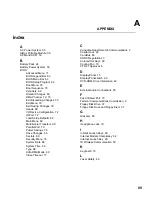
86
APPENDIX
A
BIOS (Basic Input/Output System)
BIOS is a set of routines that affect how the computer transfers data between computer components,
such as memory, disks, and the display adapter. The BIOS instructions are built into the computer’s
read-only memory. BIOS parameters can be configured by the user through the BIOS Setup program.
The BIOS can be updated using the provided utility to copy a new BIOS file into the EEPROM.
Bit (Binary Digit)
Represents the smallest unit of data used by the computer. A bit can have one of two values: 0 or 1.
Boot
Boot means to start the computer operating system by loading it into system memory. When the manual
instructs you to “boot” your system (or computer), it means to turn ON your computer. “Reboot” means
to restart your computer. When using Windows 95 or later, selecting “Restart” from “Start | Shut Down...”
will reboot your computer.
Bus Master IDE
PIO (Programmable I/O) IDE requires that the CPU be involved in IDE access and waiting for me-
chanical events. Bus master IDE transfers data to/from the memory without interrupting the CPU. Bus
master IDE driver and bus master IDE hard disk drives are required to support bus master IDE mode.
Byte (Binary Term)
One byte is a group of eight contiguous bits. A byte is used to represent a single alphanumeric character,
punctuation mark, or other symbol.
Clock Throttling
Chipset function which allows the processor’s clock to be stopped and started at a known duty cycle.
Clock throttling is used for power savings, thermal management, and reducing processing speed.
COM Port
COM is a logical device name used by to designate the computer serial ports. Pointing devices, mo-
dems, and infrared modules can be connected to COM ports. Each COM port is configured to use a
different IRQ and address assignment.
CPU (Central Processing Unit)
The CPU, sometimes called “Processor,” actually functions as the “brain” of the computer. It interprets
and executes program commands and processes data stored in memory.
Device Driver
A device driver is a special set of instructions that allows the computer’s operating system to commu-
nicate with devices such as VGA, audio, Ethernet, printer, or modem.
Hardware
Hardware is a general term referring to the physical components of a computer system, including pe-
ripherals such as printers, modems, and pointing devices.
Summary of Contents for T9A
Page 11: ...10 About This User s Manual Notes For This Manual 1 Introducing the Notebook PC ...
Page 13: ...12 Top Side Bottom Side Left Side Right Side Rear Side Front Side 2 KNOWING THE PARTS ...
Page 81: ...80 APPENDIX Internal Modem Compliancy Glossary Owner Information ...
Page 84: ...84 APPENDIX A ...
Page 91: ...91 APPENDIX A ...







































